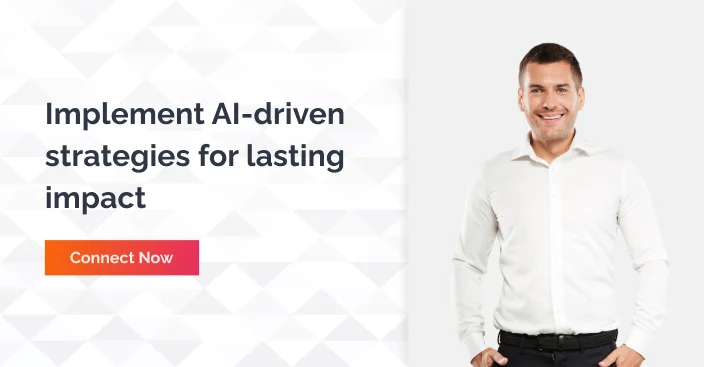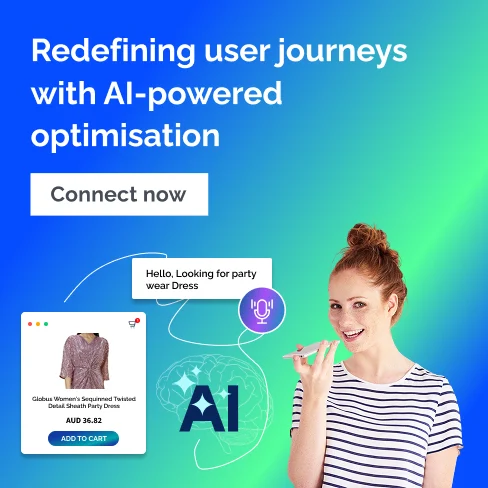Transform Engagement with Next-Gen Website Optimisation Using AEO, GEO & AI
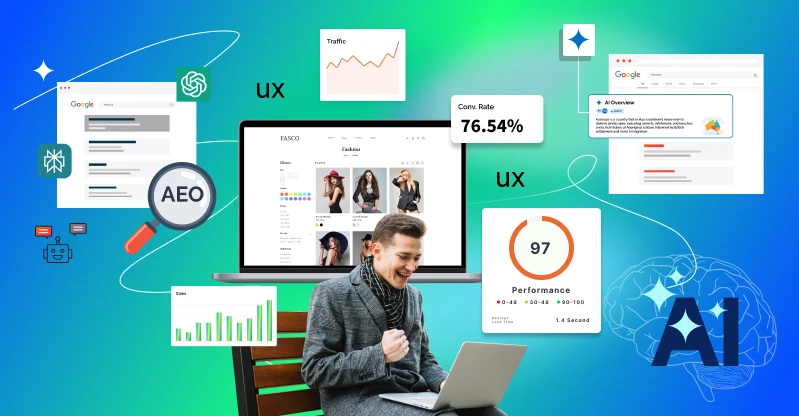
The Australian market is shifting rapidly in the digital world. It’s become highly competitive, and only using traditional SEO is not enough to survive in this market.
To generate better engagement and conversion, brands could no longer be content with merely building a website. The customers these days want tailored experiences and the ability to shift a device, location, or even searching patterns as they please.
Hence, this led to the demand for other new-age optimisation methods such as AEO, GEO, and AI. These three pillars provide a set of solid foundations on which to base engagement, relevance, and growth of the website in the long term.
This blog will help you understand how the merging of AEO, GEO, and AI can build a highly optimised website and help the user boost more engagement, conversions, and long-term online success.
The Evolution of Website Optimisation
In the early digital marketing days, companies did little more than fundamental search engine optimisation (SEO) to get listed on Google. Being successful involved putting the correct keywords in your content and obtaining high-quality backlinks.
But user behaviour changed over time. Nowadays, individuals do not simply enter keywords in a search box, but generally ask compound questions demanding direct answers and then consume the output in different forms-goodbye voice, video, or even AI-generated summaries.
The change in search engines is also significant. Search engines have become answer engines, and generative AI tools like ChatGPT, Google’s SGE, and Bing AI have changed the game of how users find and engage with information.
Therefore, website optimisation has to adopt methods that respond to these changes. This is where AEO, GEO, and AI play their roles, each taking a different role in making websites more interactive, smarter, and effective.
Defining Answer Engine Optimisation (AEO)
Answer Engine Optimisation (AEO) is all about optimising content to directly answer user questions, particularly in a voice search, featured snippet, and zero-click result world.
Rather than simply optimising for keywords, AEO sees to it that your content responds to user intent in a manner that search engines can understand and serve up immediately.
For instance, when a user searches Google and asks, “What is the best CRM software for small businesses?”, an optimally optimised site may be displayed as a featured snippet with a brief, explicit response.
AEO assists sites in grabbing attention where users anticipate getting results instantly, instead of browsing through lengthy lists of links.
The advantages of AEO are increased brand exposure, better click-through rates from featured snippets, and an increased likelihood of being selected by voice assistants such as Siri, Alexa, or Google Assistant.
Companies that implement AEO well establish themselves as authoritative sources, reaching their audience right at the moment of intent.
The Emergence of Generative Engine Optimisation (GEO)
Generative Engine Optimisation (GEO) is the new practice of optimising content to be found and recommended by generative AI engines.
In contrast to conventional search, generative AI does not present a list of links but creates extensive answers by aggregating information from several sources.
For companies, it implies that optimisation has to evolve to make their content cited, summarised, or referenced within AI-generated answers.
GEO entails developing high-quality, authoritative, and well-organised content that AI algorithms have faith in and draw into their responses.
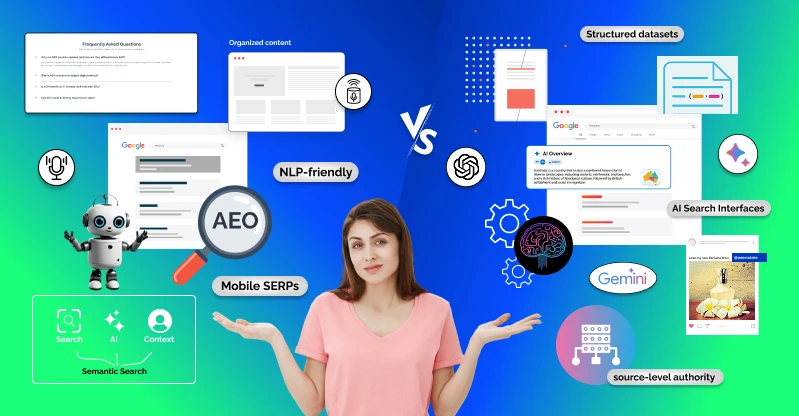
A clear example is how OpenAI’s ChatGPT or Google’s Search Generative Experience (SGE) provides summarised answers.
If your website provides detailed, reliable, and well-structured insights, it has a greater chance of being included within those AI-generated outputs. This creates not just visibility but credibility, as being cited by AI engines positions your brand as an expert.
The influence of GEO will expand as increasing numbers of users depend upon generative AI for info discovery, shopping recommendations, and choice-making. Companies that discount GEO risk lose share in a digital environment that is increasingly AI-curated.
The Role of Artificial Intelligence in Website Optimisation
Artificial Intelligence not just fuels the search and discovery process but also redefines the way companies optimise websites.
AI gives them robust capabilities for understanding user behavior, making content more personal, streamlining operations, and improving interaction.
Web optimisation by AI can include predictive analytics for anticipating what the users desire, recommendation engines to recommend products or content, and chatbots to enhance customer support.
It also makes it possible for the marketers to come up with ideas for content, conduct A/B tests, and even automate such technical SEO tasks like schema markup or internal linking strategies.
With the help of AI, the interactions can be more engaging from both sides, i.e., backend & frontend.
Let’s take the example of “dynamic customisation,” which helps to deliver multiple versions of the same webpage according to user demographics, location, or browsing behaviour.
The quality of interaction increases with customers’ ability to access information that speaks directly to them.
Why Blending AEO, GEO, and AI Matters
Although AEO, GEO, and AI all have critical roles to play, the real strength comes in integration. AEO makes your site visible in answer engines and voice search.
GEO establishes visibility within generative AI-driven results. AI, on the other hand, offers the smarts to personalise, optimise, and automate all that.
When combined, they produce a smooth optimisation plan. Suppose your AI website detects popular questions within your users, develops AEO-optimised content that explicitly answers them, and formats it for easy inclusion by generative AI engines or algorithms in the responses.
Meanwhile, the site dynamically moderates the user experience, presenting customised recommendations to keep the visitors engaged.
This integrated approach fuels higher engagement by making sure to be seen across several platforms, providing answers where and when they are needed, and making experiences relevant and personalised.
Effective Strategies for AEO Implementation
Companies can implement AEO through the development of content that positively responds to user queries in clear, organised formats.
Schema markup and FAQ pages enable search engines to better comprehend your content. Having conversational phrases and natural language is important, even more so with the evolution of voice search.
It is also necessary to build pillar pages and group content under main topics. This tactic guarantees your site becomes a trusted source of specific topics, and the chances of being selected for snippets or voice results increase.
In addition, making content short, simple, and authoritative establishes trust with users and search engines.
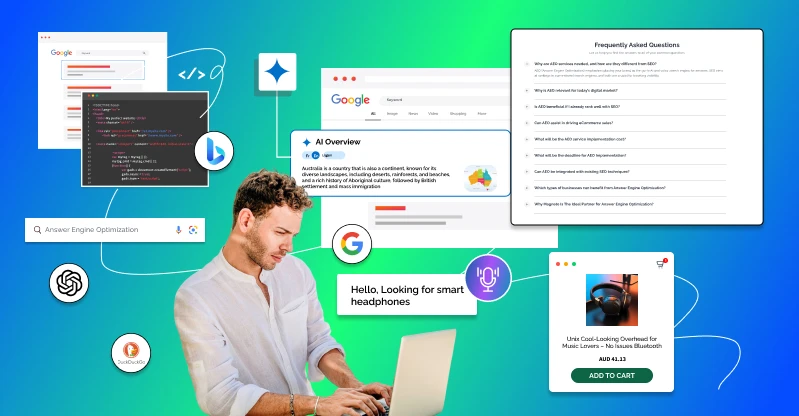
Hands-on Tactics to Enforce GEO
For GEO, companies need to prioritise creating authoritative content that AI engines can depend on. This includes citing authoritative sources, maintaining plain structure, and writing comprehensive explanations.
Generative engines appreciate transparency, so providing data, statistics, and expert remarks adds credibility.
Another important consideration is semantic optimisation. Because AI models are based on context, not keywords, companies should create content covering topics in depth.
To illustrate, a GEO-friendly article about “best running shoes” would cover shoe materials, biomechanics, applications, and professional reviews so that generative AI can extract varied insights.
Consistency and refreshing content also count. Generative engines like new and pertinent data. Sites that constantly refresh material have more opportunities to be chosen by AI-based platforms.
Strategies to Implement AI in Website Optimisation
Incubating AI tools in website optimisation involves strategic planning and technical implementation.
Brands can employ AI analytics platforms to learn about visitor behaviour, which pages have the most engagement, and where the users are exiting.
With all this knowledge, it becomes the smarter thing to do in design, content, and marketing campaigns.
A virtual assistant and an AI chatbot can be used to provide better customer support throughout the whole process and answer questions in real-time or even sell a higher-end product to a customer.
In addition, AI-based personalisation engines can alter content layout, ads, or recommendations based on user data, producing much better engagement and conversion.
Another real-life use is AI-powered SEO automation. Tools such as SurferSEO or Clearscope optimise content for semantic search, whereas software such as Jasper or Writesonic can help generate human-like text that can be edited for AEO and GEO. Blending human imagination with AI speed results in better results.
Challenges in Connecting AEO, GEO, and AI
Although the advantages are evident, companies struggle to embrace these tactics. The speed of AI evolution renders it hard to keep up, and competition for prominence in answer engines and generative content is fierce.
And there is always the danger of excessive dependency on automation, at the expense of authenticity and voice.
The execution of these strategies demands a certain technical know-how, ranging from the schema markup for AEO to the integration of an AI-based analytics platform.
A few small businesses might find it challenging to overcome these resource deficiencies; however, cloud-based AI tools and automation platforms are slowly but surely putting these technologies within their grasp.
To get over these concerns, a balanced approach has to be taken-a combination of AI and optimisation methods, combined with authenticity and creativity, alongside some human intervention.
The Future of Website Optimisation
The future is building sites that are not only discoverable but also highly engaging and trusted by both machines and humans.
As search engines increasingly become answer and generative engines, companies embracing AEO and GEO will be seen in a competitive landscape.
On the other hand, AI would become an everyday utility delivering personalisation and efficiency at scale.
What we will be seeing in the days to come are much more conversational interfaces, predictive personalisation, and immersive experiences in some forms, such as AR or AI simulations.
The ultimate objective will be to develop a seamless environment under which discovery, interaction, and conversion take place across every platform.
Conclusion
Next-gen website optimisation is no longer a choice; it’s a necessity for Australian brands that intend to stay ahead in the changing digital environment.
AEO guarantees visibility within response engines, GEO ensures that generative AI responses are relevant, and AI offers that human touch of interaction, personalisation and automation.
Put together, these three mechanisms can help build websites that rank highly in search engines, and also forge a strong bond with users by providing wonderful experiences that can create customer trust and propagate into growth.
For better understanding and implementation of their three tech to boost your engagement, you can connect with an expert and ensure an excellent outcome for your Australian brand.
FAQs
 What is the difference between AEO and GEO?
What is the difference between AEO and GEO?
AEO (Answer Engine Optimisation) is concerned with optimising content for answer engines such as Google’s featured snippets or voice assistants to make content yield direct answers to queries. GEO (Generative Engine Optimisation) optimises content for AI-driven generative engines such as ChatGPT or Google SGE to make content referenced and cited in AI-authored summaries.
 How does AI support AEO and GEO?
How does AI support AEO and GEO?
AI facilitates these tactics by monitoring user behaviour, automating SEO work, and allowing personalisation. For instance, AI tools can recognise trending questions for AEO, create topic clusters, or make content semantically rich for GEO. AI also enables optimisation of website experiences to drive engagement and conversions.
 Is AEO or GEO more crucial for Australian businesses today?
Is AEO or GEO more crucial for Australian businesses today?
Both are significant, but their importance varies based on your audience. If your customers are majorly Google search or voice assistant dependent, AEO has instant benefits. If your audience makes use of generative AI tools for info or product research, GEO is essential. The best strategy is to combine both to future-proof visibility.
 Can small businesses implement AI for website optimisation?
Can small businesses implement AI for website optimisation?
Yes. While enterprise-class AI platforms are expensive, plenty of affordable AI solutions are available for small businesses. From content generation software to chatbots and analytics platforms, small businesses can implement AI gradually to improve optimisation without grand budgets.
 What are the long-term benefits of connecting AEO, GEO, and AI for the Australian market?
What are the long-term benefits of connecting AEO, GEO, and AI for the Australian market?
Combining these tactics maintains visibility on multiple discovery paths, creates brand leadership, increases customer interaction, and converts more effectively. Over time, it makes companies respected digital leaders who are poised to respond to emerging trends in search and AI-environment ecosystems.
